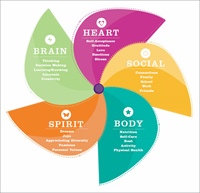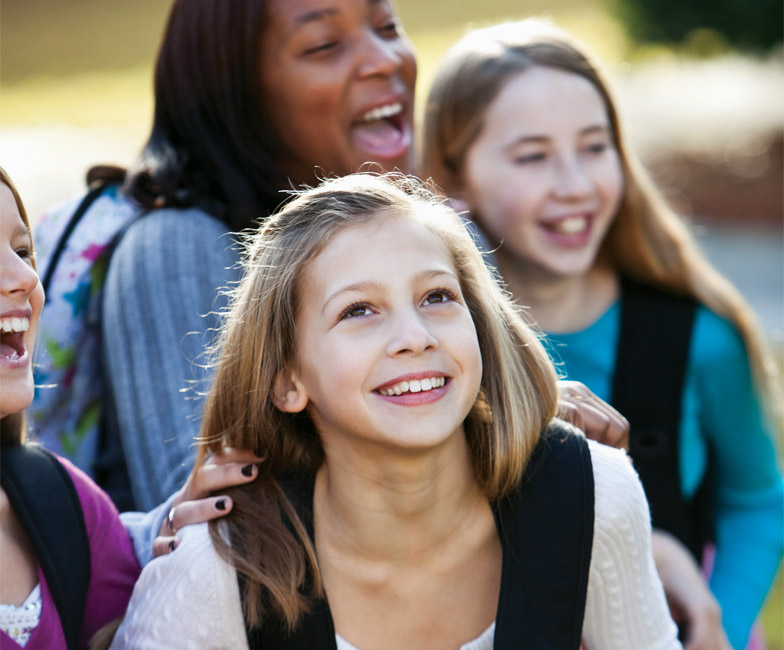Neuropsychologist Dan Siegel, in his book Brainstorm: The Power and Purpose of the Teenage Brain, describes adolescence as a time of increased elasticity in the brain. The emotive part of the adolescent brain is developing rapidly, but the rational part of the brain may not catch up for another 10 years.
As youth workers, we can view this time as something to put our heads down and get through, or as an opportunity to help youth grow, learn, and connect. Instead of seeing impulsivity and recklessness, we can see young people open to new ideas and experiences. Instead of seeing unchecked emotions, we can see young people primed to connect with others and make social change. Instead of seeing rebellion against adults, we can see opportunities to create interdependence with caring adults in the community.
At Girls on the Run, a nonprofit organization dedicated to helping every girl recognize and activate her limitless potential (see page 33), we believe young people bring a lot to the table at this age, and see adolescence as a time of opportunity. We recently created Heart & Sole, a new program for middle school girls that reflects this belief.
The Essence of Heart & Sole
Heart & Sole creates a positive, structured space for middle school girls to learn about themselves, explore new ideas, cultivate empathy, strengthen connections, and develop life skills that will help them as they move through adolescence and beyond. The trained coaches, who often are teachers at the school, meet with the girls twice a week for 90 minutes. The structured, girl-centered curriculum, written by a team of educators, is based on current research regarding physical activity, positive youth development, as well as best practice for working with middle school students, including the work of AMLE and the Harvard Family Research Project.
The program promotes physical activity (running and strength conditioning) as well as team building, setting boundaries, regulating emotions, taking a stand, making connections, solving problems, and developing empathy.
There are no specific topics in Heart & Sole. Each lesson has a Big Idea around which all activities and discussions are focused. The girls decide what they want to talk about related to the Big Idea and the questions posed, sharing what’s relevant in their lives. The girls solve problems together and the facilitators teach them skills and tools they need to face whatever comes their way.
The Girl Wheel
As a natural part of the developmental process, adolescents become more peer-focused and seek relationships outside their immediate family. This looking outward is combined with a hyper focus on self: “Am I good enough?” “Do they like me?” “Can I do this?”
Heart & Sole considered these natural tensions adolescent girls feel within themselves and, in response, developed the Girl Wheel to help them talk about these struggles and to think about themselves and others more holistically.

Figure 1:
The Heart & Sole Girl Wheel helps young adolescent girls understand the importance of balance in their life.
The Girl Wheel has five parts (Figure 1), each with distinct aspects that further define it. It’s common for adolescents to be overly focused in one area of their lives—grades (Brain), physical appearance (Body), peers (Social), or their emotional world (Heart). The Girl Wheel, which also includes a Spirit component, encourages them to think about balance in their lives and to consider how over-focus in one area may cause imbalance and stress in another area. They learn to use the Girl Wheel to identify changes they would like to make within themselves and ways they can contribute to change around them.
For example, in the area of Brain/decision making, girls might explore how they make decisions. Under Heart/self-acceptance, they would discuss what it means to accept yourself. Through the lessons and activities, they become more aware of where their strengths lie and identify areas in which they would like to grow and change. For example, one student might say, “I am already strong in Spirit because I know what my dreams for my future are. I want to grow in my Social because I often don’t make positive friends.”
As the team bond strengthens, the girls talk about obstacles and strengths and support. Using a physical obstacle course and journaling, they identify what obstacles they face in their lives, what obstacles they may face in the future, and what strengths and supports they have to help them.
Furthermore, they think about and identify what strengths and supports they need to shore up their Girl Wheel. In this way, girls are empowered to take care of themselves, to identify their support systems, and to plan how to get additional help when needed.
When the girls are more aware and knowledgeable about their own Girl Wheel, the coach introduces the idea that others have Wheels as well; they have strengths, areas in need of growth, obstacles, and need for support. The girls play several games that exemplify the concept of empathy.
One game requires that the team meet a goal, but in each round, a team member is given an additional hindrance to reaching the goal (hand behind the back, inability to talk). After the activity, the girls discuss their emotions and thoughts and make connections to the Big Idea for that day: We all face challenges.
The girls’ awareness of others’ Wheels reaches beyond the Heart & Sole team into their homes, classrooms, and neighborhoods. Girls learn to and are more willing to stand up for themselves and others. They are less willing to stand by and watch others be mistreated or ignored. They grow in connection and caring for others as they become more aware of other’s experiences and needs.
One participant said, “My mom has a Wheel?!” Later in the season, she talked about how her relationship with her mother had improved because she wasn’t so quick to judge her mother if her mother snapped at her. “I figured she hadn’t been doing self-care or sleeping a lot. Her Wheel wasn’t balanced.”
Extending the Wheel
The last part of the curriculum focuses on the community and asks the girls to identify Wheels that are closest to them and Wheels that are not. They think about how all Wheels in the world are connected—that one small action can affect many others.
The Heart & Sole team is a great example of how one member of a team can change the whole team dynamic for the positive or negative. The girls engage in many team-building activities and experience what it means to be connected and to collaborate to meet a goal. In the remaining lessons, as the girls prepare for the final 5K event, they also prepare to make a contribution to the community at large. They talk about how easy it is to care about Wheels closest to them (friends, parents, siblings) but how easy it is to overlook or ignore the Wheels that are not close to them (the new kid at school, the bus driver, the differently abled student, the clerk at the grocery store).
Just as girls work in teams and pairs to complete their practice 5K, they work in teams and pairs to make plans to extend the reach of their Girl Wheel to positively affect others. Girls make plans, enact plans, report back, and continue their efforts beyond the season. For more about this idea, visit the Making Caring Common Project (www.makingcaringcommon.org) which inspired its creation.
Caring, Connected, and Contributing
When middle school girls are given the time, space, and structure to participate in activities that allow them to explore who they are individually, who they are as part of a team, and who they are as part of a larger community, they rise to the challenge. One sixth grade participant said, “I learned what it means to be part of a team and I learned that I should help others.” An eighth grader said, “I learned to trust myself more, know who I am. To stop and think. And help someone else out, even if I don’t know them.”
When we give them the opportunity to tell us what motivates them, we can then connect them with experiences and opportunities that help them make a difference in their lives, schools, and neighborhoods. We should all see adolescence as a time of true development and wonder. We can have a lasting impact on the lives of young people if we are willing to listen.
What is Girls on the Run?
| Girls on the Run is an empowerment program for girls in grades 3–8, giving them skills and experiences to navigate their world with confidence and joy.
Meeting twice a week in small teams, we teach girls life skills through engaging lessons and fun movement activities. The curriculum is taught by certified Girls on the Run coaches and helps each girl understand and celebrate herself, value healthy relationships, and realize her power to affect the world! Running is used to inspire the girls and to encourage lasting health and fitness. At the conclusion of each program cycle, the girls and their running buddies complete a 5k running event that provides them with a lifelong memory of accomplishment. Girls on the Run has 235 councils serving more than 170,000 girls a year in North America.
To find out more about Girls on the Run or a council near you or to bring a team to your school go to www.girlsontherun.org. |
Heather Britt is vice president of programming for Girls on the Run International, Charlotte, North Carolina. hbritt@girlsontherun.org
Published in AMLE Magazine, October 2015.
